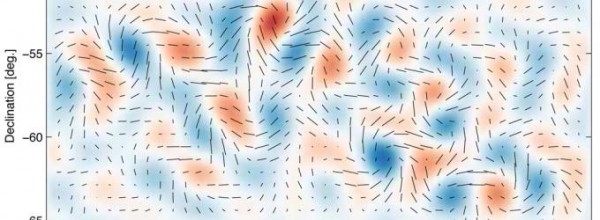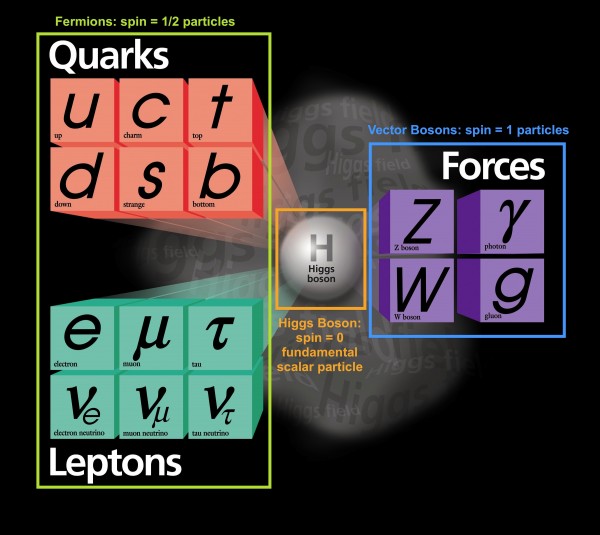“Other than the laws of physics, rules have never really worked out for me.” -Craig Ferguson
When you think about the Standard Model of particle physics, you very likely think about all the matter, energy, particles, antiparticles, forces and interactions of the Universe. And you might legitimately worry that this is all there is.
Never fear; it can't be! The Standard Model may be wonderful for what it does predict, but we know with absolute certainty that it can't be everything.
 Image credit:the BICEP2 collaboration, via http://www.cfa.harvard.edu/news/2014-05.
Image credit:the BICEP2 collaboration, via http://www.cfa.harvard.edu/news/2014-05.
- Log in to post comments
More like this
"The Universe is very, very big. It also loves a paradox. For example, it has some extremely strict rules.
Rule number one: Nothing lasts forever. Not you or your family or your house or your planet or the sun. It is an absolute rule. Therefore when someone says that their love will never die, it…
“The paradigm of physics — with its interplay of data, theory and prediction — is the most powerful in science.” -Geoffrey West
So earlier this year, the BICEP2 team shook up the world by announcing the discovery of primordial gravitational waves: a signal from the earliest stages of the Universe,…
"Other than the laws of physics, rules have never really worked out for me." -Craig Ferguson
Earlier this week, evidence was presented measuring a very rare decay rate -- albeit not incredibly precisely -- which point towards the Standard Model being it as far as new particles accessible to…
"Even if there is only one possible unified theory, it is just a set of rules and equations. What is it that breathes fire into the equations and makes a universe for them to describe?" -Stephen Hawking
After a long search spanning more than my entire lifetime (so far), the Higgs boson has finally…






Regarding your last point, Ethan. The latest, and very good, lattice QCD calculations predict two low-energy glueball states, a 0++ at ~1.6 GeV, and a 2++ at 2.2 GeV.
We have pretty good experimental data for the f0(1500), which "cannot" be a radial excitation of the f0(980) (that role is taken by the f0(1370) and f0(1710), which make the f0(1500) extraneous). The decay modes of the f0(1500) are consistent with being the 0++ glueball state.
Unfortunately, I rather doubt that either CMS or ATLAS are going to have anything intelligent to say about glueballs. They are too low energy, and they decay into just pions, which make them extremely difficult to pick out of the combinatorics of a typical TeV p-p collision.
Better limits on glueballs are going to have to come from low energy e+e- colliders, like BES-III, VEPP, or a future tau-charm factory.
Ethan, you say "Now, we do not know how to make a working theory of quantum gravity. String theory is a possibility (and maybe the only viable game in town)"
What about loop quantum gravity? I am no expert in either field, but you've been a vocal opponent of string theory for years now, why the change of heart? From calling it "Is String Theory an Unphysical Pile of Garbage?" to now saying that it might be the ONLY viable theory?? What's up with that??
;) https://www.youtube.com/watch?v=jEr038WOKFI
Very very nice post! One question though, you say "In other words, unless we get hit by a big physics surprise, the LHC will become renowned for having found the Higgs Boson and nothing else fundamental, meaning that there’s no window into what lies beyond the Standard Model via traditional experimental particle physics."
Is it because the energy required for detecting the particles required by these five problems is so high that there is no chance of building a detector that can detect them?
I checked wiki and it says this regarding graviton: "For example, a detector with the mass of Jupiter and 100% efficiency, placed in close orbit around a neutron star, would only be expected to observe one graviton every 10 years, even under the most favorable conditions. It would be impossible to discriminate these events from the background of neutrinos, since the dimensions of the required neutrino shield would ensure collapse into a black hole." Is it the same for other particles?
Ethan,
Given Max Tegmark's Op-Ed in the New York Times, are you considering changing the title of your blog to "Starts with a Little Swoosh"?
Can you explain what he means by the initial mass being less than an apple - does he mean total mass-energy beginning at less than that of an apple and somehow inflation violated the conservation of mass-energy and the result was billions of galaxies?
I think that Michael Kelsey's comment on glueballs above is important. Time maybe better spent on looking for these states than pursuing an empty desert with the LHC. I am only a layman but from what little I understand about QCD I believe that the glueball states exists. I would even think that such glueballs if found would support some aspect of Supersymmetry (my unsubstantiated opinion only).